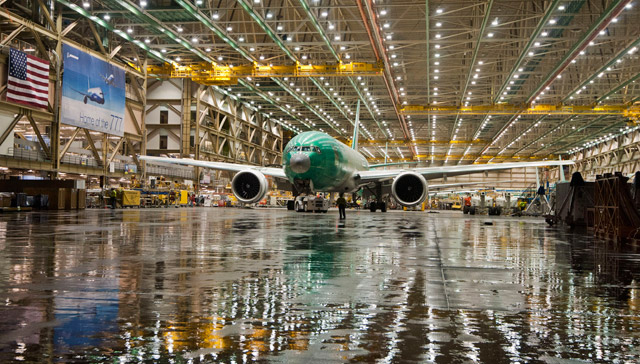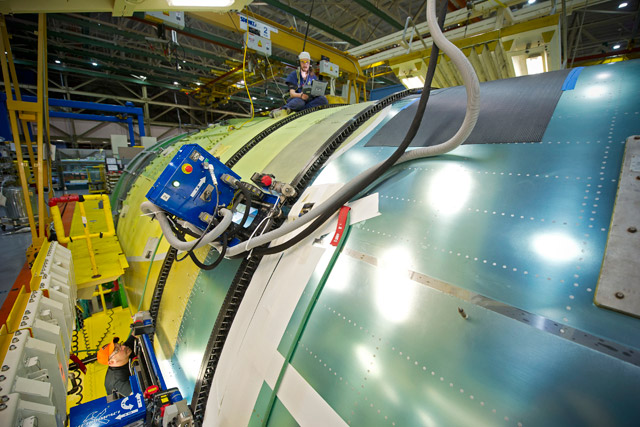Boeing has unveiled the details of performance and interior upgrades aimed at attracting 40-60 new orders this year and keeping the 777 assembly line at full rate through at least 2017.
Airbus and Boeing have attracted massive order backlogs in the last few years, but most of the orders are for new or re-engined models that have not yet entered service.
Keeping backlogs filled for existing assembly lines has not been so easy, especially for widebodies. Last month, Airbus disclosed plans to cut the A330 production rate a second time, from nine to six aircraft per month, down from 10 per month a year ago. Any further cuts in the rate could make it harder for Airbus to ramp up production of the re-engined A330neo in three years.

Boeing
Boeing is under similar pressure to keep building 777s at a rate of 8.3 per month or about 100 per year through the transition to the 777X. The first 777-9X bound for the flight-test fleet enters the assembly line in 2018, a critical year of transition for the programme.
Analysis of Flightglobal's Ascend Fleets database suggests that Boeing still has some work to do. The database shows about 15 unsold positions in 2016, but about 65 unclaimed production slots in 2017. Factoring in normal production lead times, that gives Boeing about 18 months to sign up to 80 orders for the 777, or face a rate-cut decision.
"Our first focus was to fill production line in 2016," said Boeing vice-president of marketing Randy Tinseth, speaking at the ISTAT Americas conference on 9 March.
"We're to the point we're essentially sold out [for 2016] now. I look at 2017, I look at options, I look at what's coming down the pipeline, I think we're well-positioned for 2017," Tinseth says. "We're especially excited that we're seeing movement in the cargo market."
Boeing still has several levers to pull to bring in new orders. It can offer airlines that have ordered 787s the opportunity to switch to more readily available 777-300ERs. That tactic is being pursued with United Airlines on a potential order conversation for up to 10 aircraft.
Attracting new orders from a resurgent cargo market is another option, as Tinseth suggests, but there are many doubters that this strategy will work. Although air cargo demand is trending upward for the second consecutive year, additional cargo volumes may not translate into a new wave of orders for dedicated freighters such as the 777F.
More than 300 passenger-carrying widebodies are entering service annually, each with significant space for belly cargo, says Steven Udvar-Hazy, chief executive of Air Lease. That supply has reduced demand for new freighter orders, he says: "There is room for dedicated freighters, but more and more of the freight is moving in the bellies."
This leaves the passenger-carrying version to carry the load in Boeing's campaign to fill the production skyline for the 777. As a result, Boeing has timed a performance upgrade package to appear in the third quarter of 2016, just as the current backlog begins to run dry.

Boeing
The package includes a 1.5% improvement in fuel efficiency from aerodynamic "clean-ups" of the airframe, Tinseth says. Boeing, for example, is eliminating the tailskid and updating the fly-by-wire controls to prevent a tail-strike from occurring. The slats on the leading edges of the wings will be made 60% thinner. Boeing is also improving the camber of the outer wing's trailing edge to make it more efficient. An update to the flight-control software will allow the elevator to augment stabiliser trim to reduce drag.
Another one-half percentage point improvement will come from new updates to the GE90 engine. Drawing on advances from the GEnx and GE9X programmes, GE Aviation has improved the efficiency of the blisk in the first stage of the high-pressure compressor and tightening clearances between the shroud and the blades of the nozzle in the first stage of the low-pressure turbine. Finally, GE is reintroducing an improved core-compartment cooling valve that had previously been removed from the GE90 as a result of reliability problems.
Despite those improvements, the 777 remains a tough sales challenge in an otherwise healthy orders market. Its biggest obstacle to gaining new orders may be a fundamental pricing issue. As AerCap chief executive Aengus Kelly noted at ISTAT Americas, he and other lessors would have bought dozens of A330s if Airbus had offered a steep price discount to fill the backlog. Airbus chose not to so because, Kelly says, that could have slowed the uptake of its latest products such as the A330neo and the A350.
Source: Cirium Dashboard























